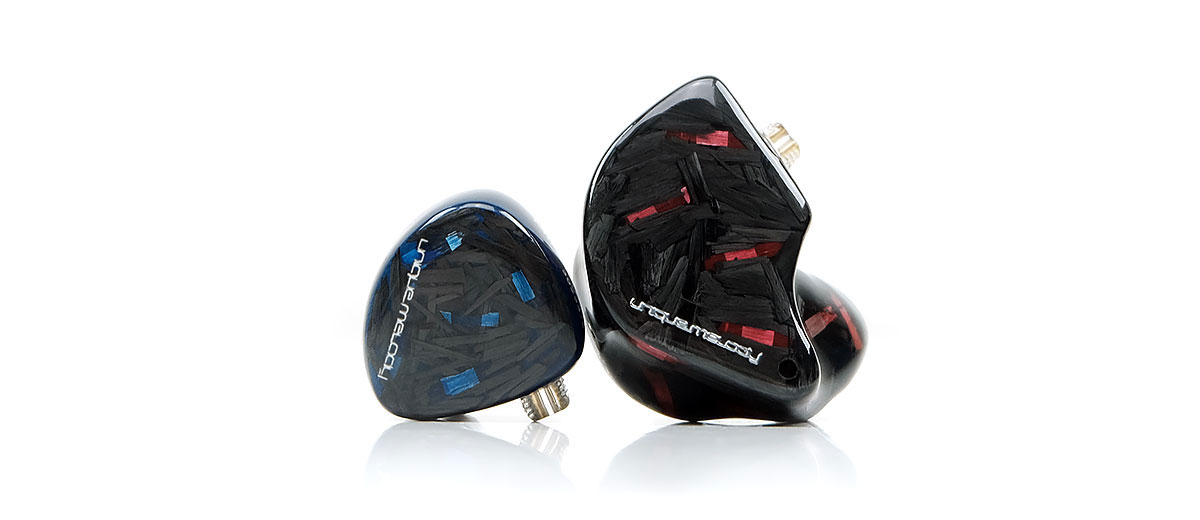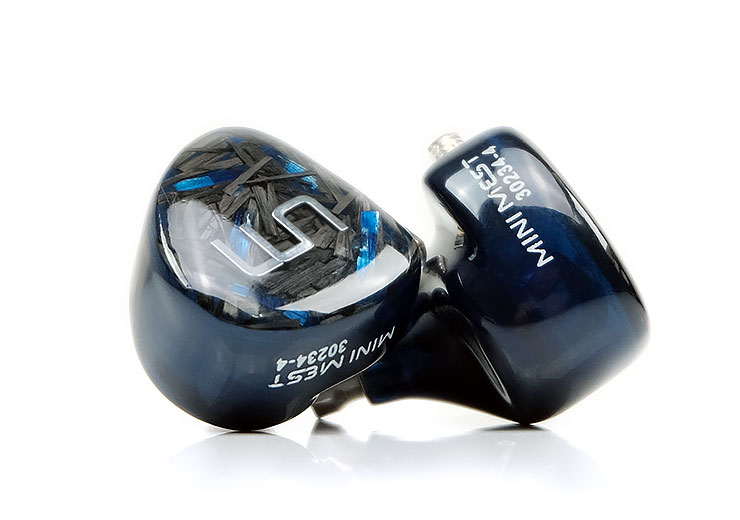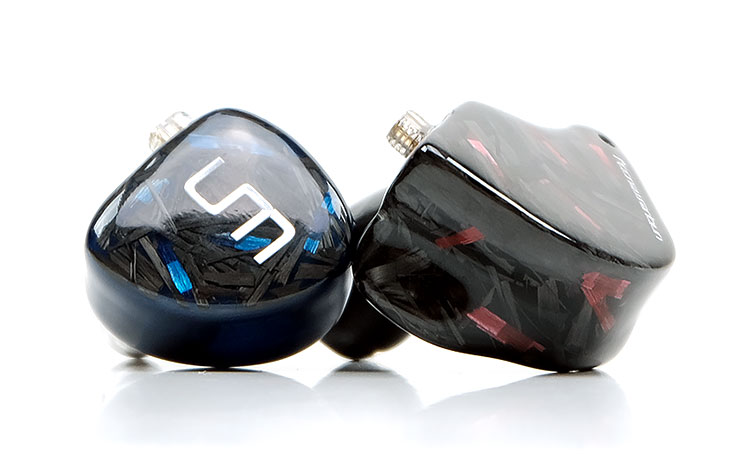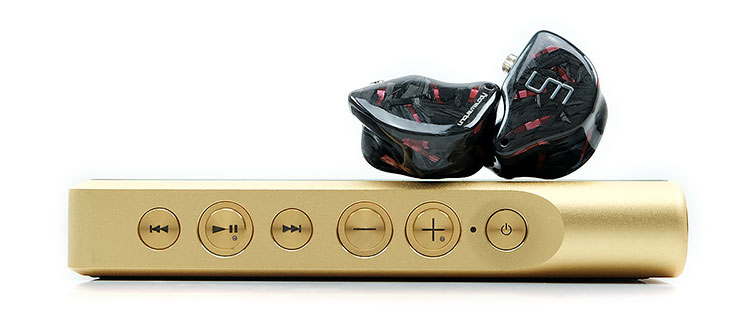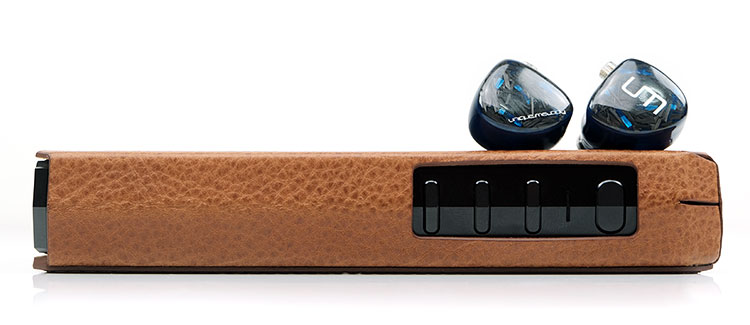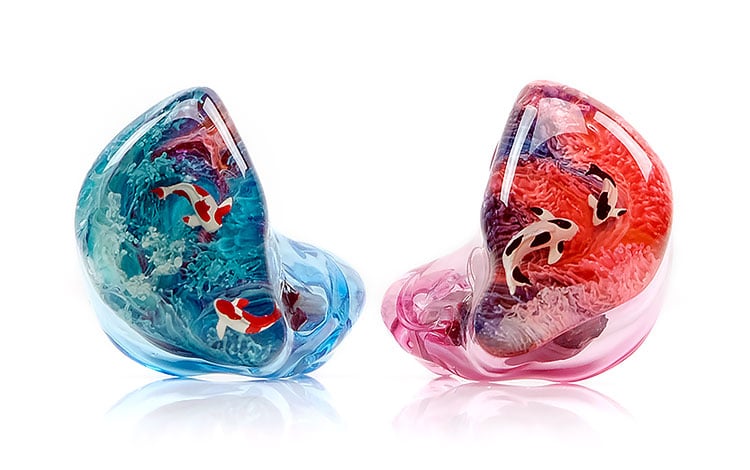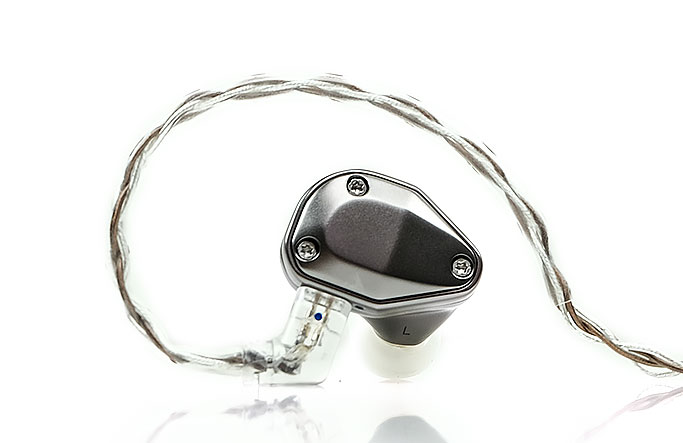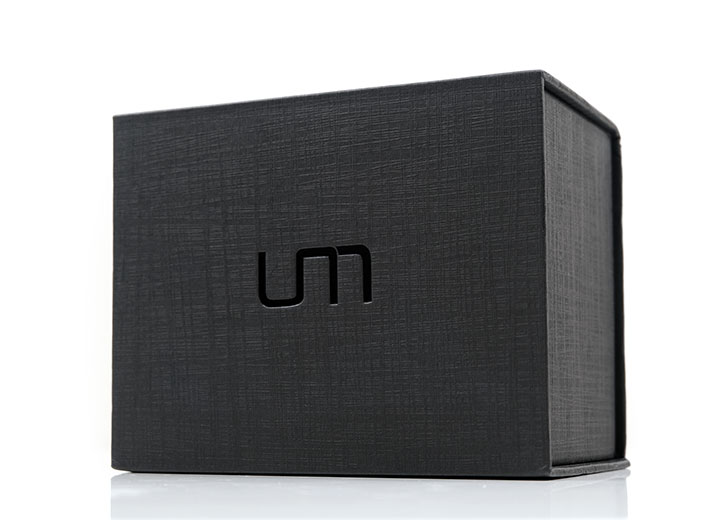Sound Impressions
MEST Summary
The tuning on the bigger MEST custom unit is fascinating. It manages to mix in a colored high-contrast u-shaped tuning with incredibly satisfying levels of resolution from almost all of our tested sources.
Whilst you can pick out the variation in the timbre each driver does bring something to the table and all combined to produce a monitor that, to be frank, competes just as well with its higher-priced Mentor and Mason flagship models.
On the low-end sub-bass has a bias over mid-bass warmth and bloom. It is not overcooked and slow sounding with excellent definition, particularly with DAPs with excellent dynamic range such as the iBasso DX220 MAX.
That slight sub-80Hz bias precedes a fast cut into the mids from about 100Hz which prevents the bass from bleeding, lightens the timbre a little, and allows the mids to sound wonderfully spacious and free of smear. The excellent transient response, quick-paced and accurate imaging cues, and excellent separation continue right throughout the mids delivering a vibrant and resolving performance.
Vocals are mixed but more to do with timbre, (see below) than technical excellence. I do sense a slight dryness to their tone with fairy short decay which does accentuate that perception of separation and air around them.
It is also helped by a very smooth 1-3k rise pushing vocals to the fore and a delicately balanced 5-7k treble that never overpowers the upper mids. That means percussion is clean, perhaps airy and light in weight but stops shy of irritating splashiness.
Treble is energetic, extended but also very evenly tuned up to around 8k. It does not suffer from any lower-treble suck out in favor of a pushed upper treble so percussion has some nice weight but not overly liquid sounding. I would say cleaner and more precise than smooth and wet.
MEST Mini Summary
This is a powerful and balanced sound with a similar high-contrast approach as the bigger MEST but with less of a focus on technical prowess and more on keeping things “fun”.
Much like the MEST, the Mini takes a more colored approach to its tuning emphasis with an impressive and fulsome sub-bass response for a BA monitor. Unlike the MEST, the Mini holds that elevation a bit longer into the mid-bass with some elegant warmth and then gently drops into a more traditional V-shaped lower-mids dip around 500Hz-1k.
The Mini also has a more exaggerated midrange bump around 1-2 with a quick drop around 3-4k to take the sting out of sounding potentially shouty sounding vocals that traverse that range. Male vocals do not have quite the excellent presence and air of the MEST with that lower-mids dip compared to female or higher pitching vocal performances which are more forward sounding.
Upper mids and highs have more of a traditional BA response with an energetic response, particularly from 5-8k but not a terribly wet and juicy sound. It does add some essential balance to that excellent low-end and compared to other all-BA creations such as the YB04 from Cayin, it does offer a lot more power and weight.
MEST Timbre
The MEST timbre is high-contrast pulling more from its sub-bass with some excellent power rather than an overly warm mid-range punch. That is combined with an energetic and clean sounding treble and a rising lower-mids from 500HZ that gives it a little bit of higher-pitched shimmer and warmer lower midrange sound.
I want to emphasize that it is not a sterile tuning, not by a long shot. Rather notes stop and start with a very precise and articulate effect rather than smear or sound rounded and slow in their pacing. You could define the timbre as having more of a light natural touch with that level of contrast taking precedence over any rich sustain effect.
The MEST’s vocal timbre is a very interesting mix of warmth and clarity. It has a certain vibrancy to it, especially with rock male vocals which rise beautifully over instrumental notes but at this same time have just the right amount of warmth from the low-end to give them some meaningful gravitas.
For example, Five Finger Death Punch’s Ivan Moody’s vocal timbre sounded absolutely spot on with the MEST in terms of clarity and space for them to breathe. At the same time, smoother more relaxed vocals such as Glen Hansard sounded accurately weighted and almost reference like in its tone.
Very high pitched female vocal timbre and percussion will take a little more odd-harmonic influence and do sound a little light in density compared to UM’s other flagship offerings such as the Mason V3+ but try as I might I never found a moment where I felt they would both would slip into a sibilant or splashy mess.
MEST Mini Timbre
What is really impressive about the MEST Mini, in general, is that low-end tuning. Not the quantity, because there is enough of it, but rather the weight and slightly longish decay giving it a bit more of a dynamic driver quality. Nothing dry about the MEST low-end with some nice warmth and above-average power or PRaT to go with it.
The BA timbre comes to the fore a bit more for me on you get into the mids and beyond with the EST drivers taken out and that lower-mids cut. It has a drier and slightly harder-edged tone for vocal timbre and a non-too rich instrumental timbre but still manages to avoid unnecessary sibilance or to sound brittle.
The treble peak from 5-7k is not hugely out of whack from the 1-2k rise and it does balance very nicely with its sub-to-mid-bass elevation so there is some coherency there to prevent too much odd or even harmonic influence from pushing your ear one way or another.
MEST Staging
The MEST is ‘big sounding’ aided by a balanced but powerful sub-bass dynamic driver performance, wonderfully separated but clean and ‘light touch’ mids and an airy but controlled treble performance.
The balance is delicate between the depth and height but balanced it very much is. There is just the right amount of elevation either side to ensure the mids do not get diffused or lost in deference to the exciting lows and highs.
That 1-2k bump is just perfect for this tuning for a nice forward but not overly forward vocal delivery. It is not shouty but rather layers just above instrumental positioning which takes its seat just behind with that lower-mids dip. Percussion is more to the fore also but again, with a slight upper treble gain fade it does not sound brash or harsh, especially with a warmer source.
UM has managed to combine all of this to produce a very vivid soundstage, a complex one also that combined excellent energy and technical capability. This is a soundstage for those who wanted maybe a less fatiguing and close sounding Mentor V3+ but felt the Mason V3+ was too liquid and calm. It strikes an excellent balance, to be honest.
MEST Mini
This is more of a traditional V-shaped tuning with a bass/treble contrast emphasis and a bump for vocal clarity. The Mini has some impressive depth for a BA monitor, well above average though not on the same level as the bigger MEST’s dynamic driver.
The lower-mids cut and pushed 1-2k presence region pushes some vocals further forward and traditional guitar and lower pitching strings slightly behind. It does not offer the same complexity as the MEST and it is not as mid-centric as the YB04.
That V-shaped tuning also creates a nice perception of staging width with the dipped lower-mids pushing the stage further back but it is not as holographic sounding as the MEST’s impressive imaging capability.
Height is very good, with no problems regarding extension and energy right up to around 8k with a slight fade thereafter. Nothing attenuated or dark at all about the Mini’s staging height.
Synergy
Efficiency
The MEST is rated at 14Ω and 118dB whereas the Mini is rated at 23Ω and 113dB SPL. On paper and in real-world source testing, the Mini is the harder of the two to drive though I would not classify either as being inefficient.
The MEST Mini does need a bit more voltage and current to match the sensitivity of the MEST. For example, going balanced on the HiBy R8, the Mini sat around 45-50 on low-gain whereas the MEST has comfortably loud at 40-45.
Both are pretty resistant to high noise floors but of the two the MEST is going to be a bit more sensitive to hiss where present. Going back again to the R8, the balanced output does have a higher noise floor with the Mini hiss levels very minor but the MEST slightly higher.
The R8 balanced noise floor is higher than the FiiO M15 with neither monitor reproducing hiss using the M15’s 4.4mm output. The MEST and MEST Mini also perform very well with the Cayin N3Pro’s tube and balanced outputs with no real concerns for hiss or high noise floor issues. Their respect channel balancing performances are also excellent from the N3Pro.
MEST Pairings
I tend to prefer a DAP with either a strong level of dynamic range or a richer weighted but well-defined response with the MEST. I felt overly neutral or clean DAPs left the MEST sounding just a shade too thin or wispy, especially from the mids upwards.
For example, the M15 tended to excite the treble a bit too much without enough low-end weight and warmth to counter it. The Lotoo PAW Gold Touch sounded more physical and punchier though still not as weighted and dense sounding as something like the Sony 1Z or the Hifiman R2R2000 which does deliver a very natural tone from top to bottom and excellent PRaT with the MEST.
The iBasso DX220 MAX will stretch the staging in just about every angle and deliver a killer midrange timbre (natural, slightly wet on the attack) and brilliant dynamic range. I can forgive the slightly light low-end for the technical excellent it can offer with the MEST.
MEST Mini Pairings
I felt the slightly safer tuning of the MEST Mini to offer a bit more versatility in terms of source timbre synergy. However, what I did gravitate to more than anything was excellent separation, and the more the better with the Mini.
The DX220 MAX is overkill I guess for the price but the dynamic range and level of separation really delivered a sublime level of articulation to the MEST Mini’s performance.
The N6ii with the E02 would be another source with great channel separation delivering a very wide soundstage and a smooth timbre throughout. It does not offer the same precise or defined low-end response but the vocal timbre is intoxicating at times which really suits the MEST Mini’s good female vocal presence.
For a fraction of the MAX price, the DX160 will give you excellent levels of separation and dynamic range also though the linear low-end might not be ideal for some looking to maximize that colored low-end of the MEST. For that, I advise the HiBy R5 balanced output for a juicer harder-hitting low-end from the MEST.
Select Comparisons
ItsFitLab Fusion
$950
Despite the price gap, I thought this might be an interesting comparison to the main MEST custom as both are trying something a little left of center in their driver configuration. They also both have a penchant for some knock-out designs for their custom builds.
Technical
The Fusion is a hybrid monitor consisting of 3 different types of drivers: an 8mm magnetostatic, a 10mm dynamic driver, and dual balanced armatures. This is a 3-way crossover with the dynamic driver for the lows, the dual BA for the mids, and the 8mm magnetostatic driver for the highs.
The MEST uses 8 drivers, with a single 10mm dynamic driver for the lows, 2 BA for the mids and upper mids, 2 BA for the highs, and 2 Sonion electrostatic drivers for the ultra-highs. The final driver being the bone conduction driver ca ross the mids and lower-highs.
A magnetostatic driver is quite different from an EST or Piezoelectric driver. This works on the same basis as some larger speaker type magnetostatic drivers in that it does not use voltage but rather current to provide its magnetic field.
Two pairs of permanent magnets are located symmetrically and independently from a membrane in between. This membrane is an ultra-thin 5-layer ferromagnetic membrane layer with high magnetic permeability that moves its entire surface without any dead point. This should minimize sound loss, transfer delay, and distortion and if done correctly.
Design
Got to give props to ItsFitLab for just about the best design in the custom business to date. I love the carbon fiber weave and red speckle of the MEST and doubtless, the shell is more durable than the plainer acrylic used by the Fusion but my god the design of the Fusion is breathtaking.
Those are actually carved Koi replica fish inside the harmonized pink and blue shells and honestly one of the best duplications of a coral reef inside an IEM I have ever seen, (is there another?).
Of course, the MEST faceplates are functional plates design to transmit those bone conduction signals to the rest of the shell so I am not sure that is the same leeway for UM to be so daring and transparent.
In terms of comfort and isolation, the MEST does better with just the slightly more accurate cut from the mold and slightly deeper penetration. Both are vented hybrids but the MEST does isolate the better of the two. I can hear it more air-con noise with the Fusion but on a mid to HF, not at an LF level where both do very well.
Cables
The Fusion uses an SPC 4-core wire whereas the MEST uses an 8-core SPC and I presume both are 26AWG. The finish on the 8-core MEST cable is a bit more eye-catching with a two-tone finish and gunmetal barrels.
The Fusion cable is more of a standard black heat-shrink jacket but the barrel are also gunmetal finish and branding. You can have multiple termination options on both with 2.5mm TRRS, 3.5m TRS, and 4.4mm options available.
The Fusion cable is lighter and easier to work with than the 8-core SPC of the MEST. However, the MEST stock has a bit more dynamic range in its performance and opens up the presentation a bit better.
Performance
The Fusion is rated at 13.1Ω and 98dB SPL compared to the MEST’s 14Ω and 118dB SPL. And yet, the Fusion sounds the easier of the two for current, though not by a huge amount.
Both tested well for noise, neither are overly sensitive IEMs. But the current gap in favor of the Fusion did surprise me. Both were tested from the iBasso DX220 MAX, Cayin N6ii/E02, and the new HiBy R8 in balanced mode with similar results.
Tuning
Ok so fairly easy in terms of discussing the differences but I do want to set out the stall quite quickly here for those wondering, the UM MEST is more resolving if not as rounded and heavy-handed on the low-end.
The Fusion does deliver a broader note weight and more bass bloom compared to the UM MEST that tilts the tuning in an unusual manner due to how ItsFitLab has slowly dropped the FR into the lower-mids. It is quite a linear slow drop compared to UM’s more aggressive cut into the lower-mids. I find this tuning tends to favor modern R’n’B tuning and female vocals more than rock.
That means the Fusion sub-bass weighting and mid-bass warmth carries quite far into the lower-mids whereas the UM Mest is cleaner, lighter into the lower-mids with slightly less instrumental presence. However, separation is much better with far less bloom so male vocals have plenty of space to breathe.
Mids Dip
For some strange reason, the Fusion drops the 1k marker behind its lower-mids so a lot of guttural vocals can sound veiled and dipped. The MEST rises from 1-3k giving a much better male vocal presence. The Fusion has a rise from 2-4k which does better with ethereal vocals like Grimes which have a bit more weight and richness compared to the thinner MEST timbre.
The stronger odd-harmonic overtone and enhanced mid-treble presence of the MEST are more energetic here so you get a lot more contrast on timbre right down into the mids. Treble on the Fusion is not as forward so it does have a bit less contrast seeping down into the midrange timbre, hence that rounded tone to instrumental and male vocal notes.
The Fusion does lack a little energy from 5-7k so percussion can sound liquid and rich but not with the same amount of bite as the MEST. I would say there would be a lot of fans of that Fusion treble tuning as it can sound sweeter in a way compared to the drier MEST treble.
Cayin YB04
$499
Technical
The YB04 price point is competitive against the MEST Mini, though instead of a single Bone Conductor and 3 BA the YB04 is an all-BA affair with 4 BA drivers in a dual-driver configuration (2 x 2).
For the mid to highs, Cayin is using 2 dual-tweeter Knowles drivers and for the lows a single set of Sonion dual-sub drivers. The crossover is a 2-way resistor-capacitor crossover. The MEST Mini uses 1 BA for the lows, a single BA for the mids, 1 for the highs, and that bone conduction driver which layers over the mids to highs.
The YB04 is rated at 30Ω and 113dB SPL compared to the MEST Mini’s 23Ω and 113dB rating. That is pretty close and it would be very interesting to see if the Knowles drivers both uses are top-vented or ‘open-air’ for both designs.
In real-world testing with DAPs such as the iBasso DX220 MAX and the Cayin N3Pro, they are very close to each other for current demand with neither really requiring much voltage nor gain to sound optimal.
Design
Very different design approaches. The YB04 is a 3-piece CNC machined aluminum shell with a matching contoured faceplate and finished with a stainless steel short “lippy” nozzle. It is bigger and heavier than the compact acrylic shell of the MEST Mini but also more durable from knocks and bumps.
The MEST Mini is the better looker aesthetically but in terms of form factor, UM missed out on the advantages of acrylic but not being terribly aggressive with the shaping. Neither monitors have amazing isolation despite not needing bass vents.
Both monitors stock tips are not that great but with a switch to Final E 3rd party tips, the isolation on both improves immeasurably as does the comfort.
The two monitors use a protruding 0.78mm 2-pin connector system but there is a slight difference in the stock cable geometry. The MEST Mini using SPC 6N 26AWG and the YB04 uses an 8-wire, (4×4), hybrid geometry consisting of a blend of OCC and a silver alloy.
Both handle extremely well with the Cayin cable offering a little less memory retention and a slightly lighter handling property. Microphonics on both is very low.
Performance
The MEST Mini is more of a “so you think it has a dynamic driver? Think again” presentation with a u-shaped high contrast tuning and a comparatively dipped mids. The YB04 is more of a traditional BA timbre with a leveled low-end, not so much weight, and a more focused and forward midrange, especially for vocals.
The Cayin timbre is more of a natural to a neutral tone for the low-end Sonion and a slightly drier and articulate mid to highs vibe from the Knowles drivers. It is not so much contrasting but more a light touch or a hi-fidelity approach to instrumental note weight and ‘purity’.
The MEST Mini is all about power, with plenty of low-end depth in comparison to the YB04. The mid-bass is second fiddle to the sub-bass which is impressive for a triple-driver BA where I would normally expect more mid-bass warmth.
It does mean the cut into the lower-mids is more aggressive so instrumental notes have less warmth beyond the strong bass fundamental. Combined with a good treble presence that is in no way brittle or splashy, the timbre on the MEST Mini is cooler than the YB04.
Both do have a midrange bump around 2k but the MEST Mini is not as amplified or as forward nor does it have as much 3-4k energy as the YB04. Vocals sit back a bit further on the MEST whereas the YB04 brings them closer to the front with a more intimate sound.
Unique Melody Mason V3+
$3199
Technical
The pricing of the MEST custom is a bit lower at $1699 compared to $3199 but given the very different configurations and drivers used I thought this would be a worthy comparison.
The driver group inside the Mason V3+ is a 4-way, 5-bore design using 4 sound tubes and 1 bore designed for their DB-GO tuning module. The configuration is 4 BA drivers for the lows, 4 the lower mids, 4 for the upper mids, and 4 for the highs.
The MEST configuration consists of 8 drivers with 4 different flavors as opposed to the all-BA 16 driver count in the Mason V3+. The MEST uses the bone conductor driver as a layer which adds a bit more rumble and flavor to the mids and lower treble. You then get a 10mm dynamic driver for the lows, 2 BA for the highs, and a dual Sonion electrostatic pairing for the ultra-highs.
Design
You can order the MEST in both custom and universal format with pricing a bit more variable for the custom version. Like the Mason V3+, however, you can avail of the new carbon fiber Dreamweaver design and for this version (custom) we opted for the black and red effect which came out rather well.
You will notice some other structural changes on the MEST. The first is the DB-Go bass enhancement module from the Mason V3+ is gone from the MEST. Instead, you have a bass venting port for the dynamic driver. That does mean the level of passive isolation is marginally reduced on the MEST compared to the Mason V3+ but only slightly so.
The other notable change is the termination connector which has reverted back to a traditional 2-pin protruding socket. That also means no dual-tone cable system but the wire is the some with a fixed 4-core 6N SPC 26AWG.
The aesthetics and handling are consistent with the original dual-tone 4-core from the V3 so it is fairly flexible, low on microphonics with decent dynamic range but not TOTL performance.
Performance
The MEST is rated at 14Ω and 118dB SPL compared to the 19.6Ω and 107dB SPL of the Mason V3+ and in real work testing the MEST can go louder faster but the gap is very small indeed.
Both of these do require a bit more current than notoriously sensitive IEMs like the Solaris or the Zeus but the at 70 steps low-gain on the Lotoo PAW Gold Touch both sounded fairly optimal to me. On the Cayin N6ii/E02 pairing both were closer to 50 on the low-gain setting.
Noise is not a factor with either of these, even on known high noise floors like a higher gain 4.4mm balanced from the FiiO M11 or the R2R2000’s more aggressive amping stage.
Tuning
Hugely different sound signatures with the MEST subscribing more to the Mentor V3+ V-shape with an exciting high contrast sound over the voluminous but warmer sound of the Mason V3+. You will hear a lot more high energy contrasting overtones in the MEST timbre whereas the Mason V3+ is comparatively darker and smoother sounding.
On the low-end, both have excellent quantity levels but the MEST is a little more impactful below 80HZ with that dynamic driver when called on. The MEST’s low-end also has that juicy dynamic driver texture compared to the lighter BA timbre of the Mason V3+.
By throwing the DB-GO bass module to the max I can match the MEST for quantity but it is not quite as physical or as elevated sub-80Hz. However, the MEST does not have a huge mid-bass elevation, being more L-shaped from 20Hz to 800hz. This can often leave the MEST sounding the leaner of the two if there is not a huge amount of sub-bass energy in the music.
What the Mason V3+ does differently is to extend the elevation a bit further into the mid-bass so it delivers more warmth and a richer texture into the lower-mids. Instruments sound weighted but detailed and have a smooth even-harmonic timbre. Instruments do not quite have the same body and presence on the MEST with a bias to a forward upper mids over the lower-mids.
Vocals can leap out at you on the MEST whereas the Mason V3+ vocals are more rounded and more laid back. That 4-6k dip is the Mason V3+ makes a difference on warmer DAPs but if you can equalize that via PMEQ by around 2-3dB it can sound a lot more natural sounding than the MEST’s brighter treble presence.
Our Verdict
The MEST and MEST Mini are two very interesting and fun sounding creations from Unique Melody. The MEST in particular is world-class and I do wonder if they underpriced the darn thing given the Mason V3+ is almost twice the price.
Sssh, best not mention that too loudly but this could well be the high-end bargain of the year for custom monitors. If there is ever such as thing as High-end ‘bang-for-buck’ then the MEST takes the award with a very resolving yet vivid and exciting tuning.
The Mini sets its stall out too with its powerful low-end V-shaped musical delivery and creates a very welcome contrast to the pure hi-fidelity tones of some of its all-BA competitors.
It is beautifully designed in keeping with its bigger brother and comes with a good-quality cable. It might be worth some tips rolling with the Mini with some stronger 3rd party alternatives such as SpinFit or Final E for a better seal. It does make a qualitative difference to the final sound.
Overall, I think Unique Melody proves they are prepared to take a risk with new ideas, and with the MEST it really works incredibly well. If you want the flavor of that bone conduction on a budget then the MEST Mini is very sensibly priced also.
MEST Specifications
- Frequency response range: 20Hz-55KHz
- Sensitivity: @1KHz 118dB
- Impedance: 14Ω
- Driver Count: 8
- Crossover: 5-way crossover system
- Driver Configuration: 1 Dynamic low + 2BA Mid-high + 2BA High + 2 EST Ultra-high + 1 Bone Conduction
MEST Mini Specifications
- Driver Counts: 4
- Frequency Response: 20Hz~20KHz
- Impedance: 23Ω
- Sensitivity: 113dB@1KHz
- Driver Combination: Open-air BA Drivers + Bone Conduction Driver
- Driver Configuration: 1 Bass + 1 Mid + 1 Treble + 1 Bone Conduction




